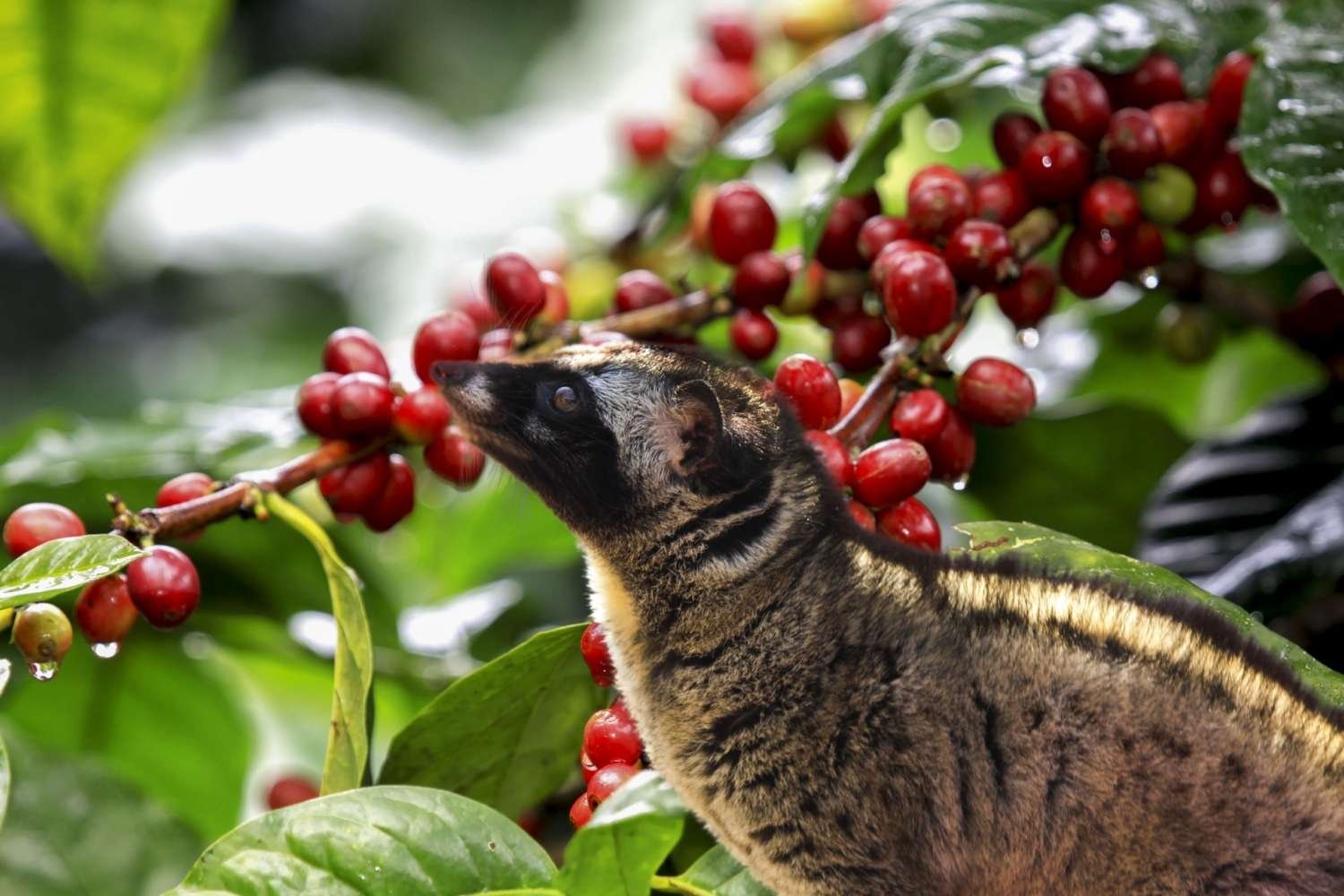The Ultimate Guide to Luwak Coffee Beans: From Harvest to Cup
Coffee enthusiasts around the world continually seek unique and exotic flavors, and one such gem in the world of coffee is Luwak coffee. Also known as civet coffee, this rare and prized brew is made from beans that have passed through the digestive system of a civet, a small mammal found in coffee-producing regions. In this ultimate guide, we will delve into the fascinating journey of Luwak coffee beans, from their harvest in the wild to the intricate process that leads to the creation of this extraordinary cup of coffee.
Table of Contents
The Civet Coffee Connection
The story of Luwak coffee begins with the civet, a nocturnal creature with a keen sense of smell and a taste for ripe coffee cherries. In the wild, civets roam through coffee plantations, selecting only the finest and ripest cherries for consumption. Once ingested, the cherries go through a unique fermentation process in the civet’s stomach, where enzymes break down proteins, ultimately impacting the flavor profile of the coffee.
Harvesting Luwak Coffee Beans: A Delicate Dance with Nature
The first step in the journey of Luwak coffee is the careful and selective harvesting of coffee cherries. Farmers in regions where civets are prevalent must be vigilant in allowing the civets to choose the cherries naturally. This process requires a delicate balance between human cultivation and the involvement of the civets. It is crucial to maintain an environment that encourages civets to roam freely without disrupting their natural behavior.

The process of harvesting Luwak coffee beans is a delicate dance between human cultivation and the instinctive behaviors of civets, the small nocturnal mammals that play a pivotal role in the creation of this extraordinary brew. This phase of Luwak coffee production requires a profound understanding of the natural habitat of civets, the art of selective cultivation, and the careful observation of the intricate dynamics between the creatures and the coffee plantations.
1. Natural Habitat Understanding
Civets thrive in specific coffee-producing regions, where their natural habitats intersect with lush coffee plantations. These regions often include tropical climates and diverse ecosystems that create an ideal environment for both the civets and the coffee plants. Understanding the natural behavior of civets in these settings is fundamental to the harmonious coexistence necessary for the creation of Luwak coffee.
2. Selective Plantation Management
Harvesting Luwak coffee beans begins with the careful management of coffee plantations. Farmers must strike a balance between cultivating coffee cherries for commercial purposes and providing an environment conducive to the wild civets. This involves maintaining biodiversity, preserving natural habitats, and ensuring that the civets have access to the coffee cherries in their natural setting.
3. Encouraging Natural Foraging
Unlike traditional coffee harvesting, where humans pick the cherries at a specific stage of ripeness, Luwak coffee relies on civets to act as nature’s discerning selectors. Farmers must encourage civets to forage freely in the coffee plantations, allowing them to choose only the ripest and most flavorful cherries. This natural selection process, driven by the civet’s keen sense of smell and taste, is integral to the unique flavor profile of Civet coffee.
4. Monitoring Civet Behavior
Farmers often employ observational techniques and, in some cases, technology to monitor the behavior of civets. This includes studying their movement patterns, feeding habits, and preferences for certain types of coffee cherries. Some coffee plantations even use motion-sensor cameras to gain insights into the civets’ nocturnal activities, enabling a better understanding of their role in the Luwak coffee production process.

5. Conservation and Education
In addition to managing the coffee plantations, there is a growing emphasis on conservation efforts and education programs. These initiatives aim to raise awareness about the importance of preserving the natural habitats of civets, not only for the production of Luwak coffee but also for the ecological balance of the entire ecosystem. Farmers, conservationists, and local communities collaborate to ensure the sustainability of both the civet populations and the coffee industry.
6. Harvesting Techniques
Once civets have selected and consumed the ripest coffee cherries, the next step is to collect the beans from the civet’s feces. This process requires a meticulous approach, as the beans must be separated from other materials and thoroughly cleaned to remove any impurities. The beans are then sun-dried before undergoing the roasting process.
7. Quality Control and Ethical Considerations
Quality control is paramount in the harvesting phase to ensure that only the highest quality beans are used for Luwak coffee production. Ethical considerations also play a crucial role, with an increasing focus on responsible and sustainable practices. Ethical Luwak coffee production involves respecting the natural behaviors of civets, allowing them to roam freely, and avoiding practices that compromise their welfare.
In conclusion, harvesting Luwak coffee beans is not just a process; it’s a harmonious interplay between nature and human cultivation. It requires a deep understanding of the natural world, a commitment to ethical practices, and a dedication to preserving the unique flavors that emerge from this extraordinary journey. As coffee enthusiasts savor their cup of Luwak coffee, they are not just enjoying a beverage; they are partaking in a tale of ecological balance and the delicate dance between the wild and the cultivated.
Natural Fermentation Process
Once the civet has ingested the coffee cherries, the fermentation process begins. This natural fermentation is one of the key factors that contribute to the unique flavor profile of Luwak coffee. The enzymes in the civet’s stomach break down proteins and alter the chemical composition of the beans, resulting in a smoother and less acidic flavor.
Collection and Cleaning
After the beans pass through the digestive system of the civet, they are excreted along with other fecal matter. The collected beans undergo a rigorous cleaning process to remove any remaining impurities. This involves thorough washing and sometimes a period of fermentation to ensure that only the pristine beans are retained for further processing.
Sun Drying and Roasting
Following the cleaning process, the Luwak coffee beans are spread out to dry under the sun. Sun drying is a crucial step that impacts the final flavor and aroma of the coffee. Once dried, the beans are roasted to perfection. Roasting is an art that requires precision and expertise to unlock the rich flavors developed during the fermentation process. The roasting process can significantly influence the taste, ranging from light and fruity to dark and robust.
The Art of Brewing Luwak Coffee: Elevating the Extraordinary
Now that the Luwak coffee beans have undergone a journey of natural fermentation, careful collection, cleaning, sun drying, and roasting, it’s time to brew the ultimate cup. The brewing process is where the true essence of Luwak coffee comes alive. Whether prepared using a traditional drip method, French press, or other brewing techniques, the unique flavor notes, and low acidity of Luwak coffee shine through, offering a distinctive and unforgettable experience for coffee connoisseurs.
Brewing Luwak coffee is an art form that transcends traditional coffee preparation methods. From selecting the right grind size to embracing the nuanced flavors developed during the intricate journey of the Luwak coffee beans, every step in the brewing process contributes to unlocking the full potential of this exceptional brew.
1. Selecting the Beans
The journey of brewing Luwak coffee begins with the careful selection of beans. Coffee connoisseurs often choose freshly roasted and ground Luwak coffee beans to ensure the preservation of the unique flavor notes obtained through the fermentation process. The distinct lack of bitterness and low acidity make Luwak coffee beans particularly well-suited for various brewing methods.
2. Grinding with Precision
The grind size is a critical factor in the brewing process. For Luwak coffee, a medium grind is often recommended, allowing for a balanced extraction of flavors. The goal is to maintain consistency in the grind to ensure an even extraction during brewing. This precision in grinding plays a vital role in capturing the rich and complex taste profile of Luwak coffee.
3. Choosing the Brewing Method
Luwak coffee can be brewed using various methods, each offering a unique experience. While some enthusiasts prefer the simplicity of a pour-over or drip coffee maker, others opt for immersion methods such as French press or AeroPress. The choice of brewing method allows for customization, letting individuals tailor the brewing process to their preferences and highlighting specific flavor nuances of Luwak coffee.
4. Water Temperature and Ratios
Maintaining the right water temperature is crucial in extracting the flavors without compromising the delicate nuances of Luwak coffee. Water that is too hot may result in a bitter brew, while water that is too cold may not extract the full range of flavors. Striking the right balance and adhering to proper coffee-to-water ratios is essential for a well-rounded and satisfying cup.
5. Brewing Time and Patience
The art of brewing Luwak coffee requires patience. Unlike some quick-brewing methods, allowing the coffee to steep or percolate over time is often key to unlocking the subtleties of Luwak coffee. This slow process enables the water to interact with the coffee grounds more thoroughly, extracting the rich flavors developed through the fermentation process.
6. Savoring the Aromas
As the aroma of freshly brewed Luwak coffee fills the air, connoisseurs are treated to a sensory experience like no other. The unique combination of chocolatey, caramel, and earthy notes emanates from the cup, tantalizing the senses and setting the stage for the tasting experience that follows.
7. Tasting Notes and Appreciation
The final act in the art of brewing Luwak coffee is the tasting. As enthusiasts take that first sip, they are greeted with a symphony of flavors that dance across the palate. The absence of bitterness and the smooth, low-acid profile make Luwak coffee a rare and delightful indulgence. Tasting notes often include hints of dark chocolate, caramel sweetness, and a subtle earthiness, creating a complex and layered experience for the discerning palate.
8. Pairing with Complementary Flavors
To enhance the Luwak coffee experience, enthusiasts often experiment with pairing it with complementary flavors. Chocolate, nuts, or even a delicate pastry can elevate the tasting experience, creating a harmonious blend of textures and tastes that accentuate the unique qualities of Luwak coffee.
9. Ethical Considerations in Brewing
Beyond the technical aspects, ethical considerations also play a role in the art of brewing Luwak coffee. Ensuring that the beans are sourced responsibly, supporting sustainable practices, and promoting the welfare of civets are integral components of the brewing process. Ethical consumption adds an extra layer of satisfaction, knowing that each cup contributes to the preservation of a delicate ecological balance.
In essence, the art of brewing Luwak coffee is a celebration of the extraordinary. From the careful selection of beans to the precision in grinding, brewing, and savoring, each step is an opportunity to appreciate the unique journey these beans have undertaken. Luwak coffee transcends the ordinary, inviting enthusiasts to embark on a sensory adventure that combines nature’s craftsmanship with the skill of the brewer, resulting in a cup of coffee that is truly one of a kind.
Flavor Profile and Tasting Notes
Luwak coffee is celebrated for its smooth, low-acid profile and unique tasting notes. The fermentation process imparts a distinct lack of bitterness, making it a favorite among those who find traditional coffee too sharp. Tasting notes often include hints of chocolate, caramel, and a rare earthiness that sets Luwak coffee apart from other brews. The absence of certain undesirable compounds contributes to its smooth texture, making it a delicacy enjoyed by coffee enthusiasts worldwide.
Ethical Considerations and Sustainability
The increasing demand for Luwak coffee has raised concerns about the ethical treatment of civets in the industry. Unscrupulous practices, such as caging civets for mass production, have tarnished the reputation of this unique coffee. Ethical and sustainable sourcing is essential to ensure that civets roam freely in their natural habitat, contributing to the ecological balance of coffee plantations.
The Future of Luwak Coffee
As the world of coffee evolves, so does the appreciation for unique and rare brews like Luwak coffee. Coffee enthusiasts, farmers, and conservationists are working together to promote ethical and sustainable practices, ensuring the welfare of civets and the preservation of this exceptional coffee tradition. The future of Luwak coffee lies in the hands of those who appreciate its unique journey, from the wild coffee plantations to the cup, savoring each sip of this extraordinary brew.











